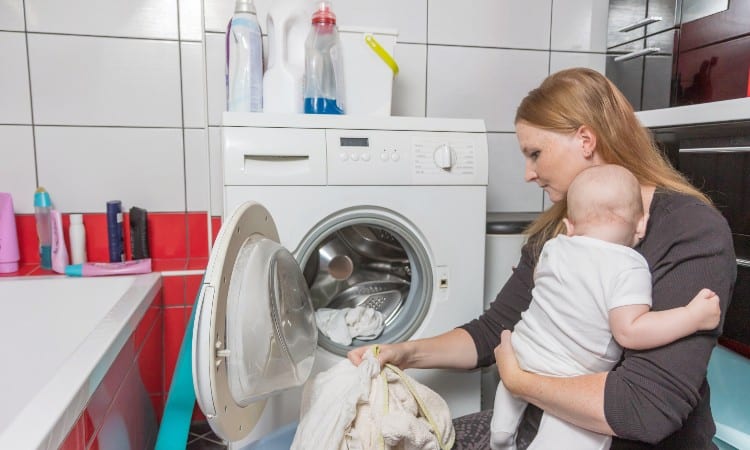Last updated May 5, 2023
Doing bulk loads of laundry by hand has, for the most part, gone by the wayside, and many people opt to do laundry in the convenience of their homes. A laundromat can provide an easy and accessible way to clean your clothes for those who don’t have access to their laundry room. But, if you haven’t paid for laundry recently, you may be wondering how much it costs to do a load of laundry at a laundromat.
Doing laundry at a laundromat will cost around $2.00 to $4.00 per load. The cost for drying will be in a similar range, with final amounts depending mainly on how much time it takes the load to dry.
In this article, we will go over what it costs to do a load of laundry at a laundromat, as well as what the costs come out for a load of laundry done in a home machine. We will cover other specifics of doing laundry at a laundromat and the pros and cons of doing laundry at home.

Quick Navigation
- How Much Does a Load of Laundry Cost at a Laundromat?
- Cost of Doing Laundry at Home
- Doing Laundry at Home Vs. Doing Laundry at the Laundromat
- How Long Does It Take To Do Laundry at a Laundromat?
- Are Laundromat Machines Better?
- How Much Does It Cost to Dry Clothes at a Laundromat?
- How to Reduce the Cost of Doing Laundry
- Conclusion
How Much Does a Load of Laundry Cost at a Laundromat?
The price to do laundry at a laundromat isn’t fixed. It can vary by location – what city you live in and the location of individual laundromats. On average, one can expect to pay between $2 and $4 per load at a laundromat – though that price can fluctuate up or down.
To get an accurate estimate of rates in your area, it would be a good idea to compare a few different laundromats. Keeping in mind that the lowest price isn’t always going to be your best option. You want the place to be sanitary, and you’ll want machines that are kept clean and run smoothly and efficiently.
Besides the actual cost to use the washing machines at a laundromat, there are a couple of other costs you may want to factor in to get an accurate cost overall. Transportation to and from the laundromat should be considered, as well as the need to pay for drying time. Each load of laundry will cost about $5 to wash and dry.
If your household does four loads of laundry per week, this cost comes to $20 per week, approximately $80 per month, or just under $1000 per year – plus a few bucks extra for transportation. Depending on your household size, the number of loads you do per week can vary greatly. This figure should at least give you an idea of the long-term cost of using a laundromat.
Optimize Visits to the Laundromat
If doing laundry at the laundromat is your choice, try and optimize your time with each visit. One of the biggest pros of doing laundry at a laundromat is the ability to wash multiple loads at the same time. This cuts down on a lot of time spent waiting – as you do with individual loads at home – so be sure to come with all the items that need cleaning.
Another thing to remember is to bring your own laundry supplies. It may seem like an inconvenience to lug around jugs of laundry detergent. Still, it can save you significantly since purchasing the products that laundromats provide can be exponentially more expensive. You may also want to consider using laundry detergent sheets which are very lightweight and have the added bonus of being waste-free!
If you can, bring work that can be done remotely with you to the laundromat. This way – between switching loads from the washer to the dryer and folding – you can also make progress on other projects that need completing. On the other hand, this could also provide a great time to catch up on some leisure reading. Bringing a book or magazine you’ve wanted to read is also a good choice.
Cost of Doing Laundry at Home

At first glance, it may appear as if doing laundry at home costs nothing more than the price of detergent. While the obvious costs – transportation and the direct costs of using the machines – are eliminated, some imperceptible costs still need to be considered with home laundry. The main costs of doing laundry at home are the cost of water and energy used for running the washer and dryer. As well as the initial expense of purchasing the machines themselves.
Based on national averages – the energy cost for an hour-long wash cycle is about $0.14 and 45 minutes of dry time is about $0.45, water and sewer will run about $0.88. For a household that does four loads of laundry per week, this comes out to $5.88 each week, about $23.52 per month, or just under $300 per year.
The cost to do laundry at home is significantly lower per load – if you already own the machines. The purchase of the appliances can run anywhere from $750 to $4000 – but with an average lifespan of around 10 years – even factoring in this additional expense, doing laundry at home will be more budget-friendly.
Take Care of Your Appliances
Since the washer and dryer are an initial investment when committing to a home laundry program, it is important to take care of your machines. Making sure you are doing laundry correctly can ensure that the machine’s life is at its maximum. While regular maintenance and biannual deep cleans will help keep machines in great shape – hopefully, helping avoid the need for any costly repairs or replacements.
Doing Laundry at Home Vs. Doing Laundry at the Laundromat

As with most things in life, there are pros and cons to doing laundry either at home or at the laundromat. Of course, the main benefit of having your own machine is convenience. Throw a load in whenever the mood – or the necessity – strikes and continue doing what you were doing about the house.
You don’t have to make additional trips, and it’s not super important to do all the laundry in one go. On the other hand, you need to keep up with the maintenance. Keeping your machine clean and in good running condition are paramount to ensuring that the machine will last and continue to clean your clothes efficiently. Of course, there is also the initial cost of purchasing the machine and the ongoing cost of energy and water necessary to run them.
Going to the laundromat can seem like a hassle when you have to transport your clothes across town, and of course, there is the downside of paying the price per load. But the good news is that you can easily get all the laundry done at once! Not only by doing multiple loads simultaneously – but their industrial-sized machines can also accommodate larger individual loads.
You don’t have to worry about the upkeep of the machines at the laundromat, and you can rest assured knowing that the washing machines and dryers at the laundromats are more powerful and efficient. Using a laundromat also provides a great opportunity to wash bulkier items – like sheets, towels and comforters – that are sometimes too big to thoroughly clean in a home machine. It can also allow designated time to get some work or reading done.
How Long Does It Take To Do Laundry at a Laundromat?

Doing a load of laundry at the laundromat will take a similar amount of time to complete as it does at home. Depending on the cycle you choose – washing can take anywhere from 25 to 40 minutes. Drying time is generally in the same range or a bit longer.
It’s important to note that if you’re doing multiple loads at once – as long as there are enough machines available to accommodate each load – the time doesn’t increase with the number. It is a good idea to allow about 2 hours worth of time for your trip to the laundromat – perhaps slightly longer if you plan on doing the folding while there.
Are Laundromat Machines Better?
The washing machines found at laundromats are significantly larger and more efficient than home washing machines. Even though they generally use less water overall – the larger capacity makes it easier for the machine to do a thorough job of getting clothes clean. This means you can wash larger loads and not compromise the result. Commercial washing machines are also more sustainable since you can do more laundry at once and they will still use much less water.
How Much Does It Cost to Dry Clothes at a Laundromat?
The cost to dry clothes at a laundromat is calculated by the time needed to dry – generally, each $0.25 will buy you 6 to 8 minutes of dry time. It will cost about $2.50 to run the dryer for an hour. The benefit of the industrial dryers found at laundromats is that they are larger and more efficient – just like their washing machines.
You can fit larger loads into these machines and – more often than not, they will only take about 40 minutes to dry as compared to an hour in a home dryer. Forty minutes of dry time will cost you under $2.00.
Laundry Service
If you loathe doing laundry, full service laundry is another option – but it’ll cost you. Standard laundry service includes detergent, washing, drying, and folding! For laundry that is pristine and ready to wear without lifting a finger – starching and ironing can usually be added at additional costs.
Full service laundry is charged by the pound and, in some instances, can include free pick up and delivery, or it can be added at an additional fee. The price to have your laundry done for you – from beginning to end – can range from $1 to $2 per pound.
Keep in mind that a standard home washing machine can hold approximately 12 pounds of clothes – an industrial machine up to 75! So, at a minimum of $12 per load – while the convenience is unbeatable – the price makes sending out the laundry a luxury.
Large items can also be sent off to be laundered for you. These include items such as comforters of all types, pillows, sleeping bags, and drapes, and are generally charged on a per-piece basis, depending on the item’s specifics. Costs can range anywhere from $6 for a pillow to $25 for a king-sized down duvet.
How to Reduce the Cost of Doing Laundry
Laundry is a part of life, whether we wash it at home or the laundromat. Since it is an unavoidable chore, here are a few tips you can use to reduce the amount of money spent on doing laundry:
- Wash less often. The average person washes their clothes much more frequently than necessary. Consider each item before throwing it into the hamper – is it something that was only worn for an hour and could easily be worn again before washing? Or a shirt that has been drenched with sweat from a morning workout? Use your best judgment and calculate which items can be reworn and which ones must be washed.
- Pay attention to the wash cycle settings. Using a high level of water for a small laundry load is a waste! Additionally, using hot water to wash uses much more energy than washing with cool or cold. While it’s easy to simply press ‘start’ on the machine, adjust the settings to appropriately match the size and type of laundry going into the machine.
- Use less detergent. Most people are prone to think more is better, but in the case of laundry detergent, it’s the opposite. Since it is highly concentrated, using too much laundry detergent can lead to less clean clothes and machines that are dirtier. When you put too much detergent in with your laundry, a regular cycle won’t be able to rinse it all away – especially in high-efficiency machines that use less water. It can also lead to build-up in the machine, which contributes to mold and mildew growth that causes – even clean – laundry to smell bad. Go against your instincts and opt for slightly less detergent rather than too much.
- Always empty the lint screen! Clean lint screens ensure that your dryer is running efficiently. A clog in the machine will make the machine work harder, taking longer to dry a load and driving up energy costs. A lint clog can also be hazardous – leading to fires in the machine.
- Dry full loads – while not overfilling the dryer. It may seem counterintuitive, but drying full loads of laundry is much more energy efficient than drying small loads. Drying small loads wastes energy. Alternatively, if you overfill the dryer, there won’t be enough room in the drum for clothes to tumble and dry efficiently. Leading you to need to run the machine for longer and use more energy.
- Dry on low heat. Dryers will use much less energy when drying on a low setting vs. a hot one. Even if it takes slightly longer for the load to dry – the overall amount of energy exerted will be less. Plus, it will be easier on your clothes, making them last longer.
- Air dry your clothes! The best way to save energy – and money spent on it – is to hang dry your clothes. Especially in those warmer months, hanging your clothes in the sunshine is the best way to get them dry naturally – with the added bonus of the sun killing bacteria and getting rid of light stains.
- Get energy-efficient machines. If you have an older model washer and dryer and are due for an upgrade, make sure to get something energy efficient. It may not seem like it makes a difference initially, but in the long run, it can greatly reduce energy expenditure and costs overall.
Conclusion
Since none of us will be able to escape the task of doing laundry altogether, this guide will help you compare the best way for you to get the job done. Will you opt for a machine in the home where you can do a load any time, at your leisure? Or put it on your calendar and make a weekly trip to the laundromat to do it all at once? Either way, you should feel satisfied knowing you have all the laundry information right at your fingertips and that you’ve made an educated choice!